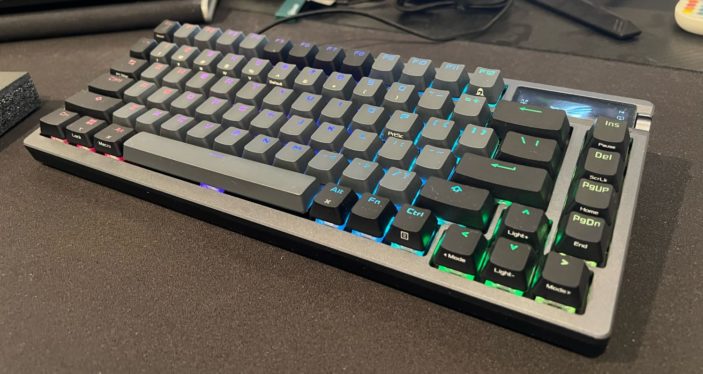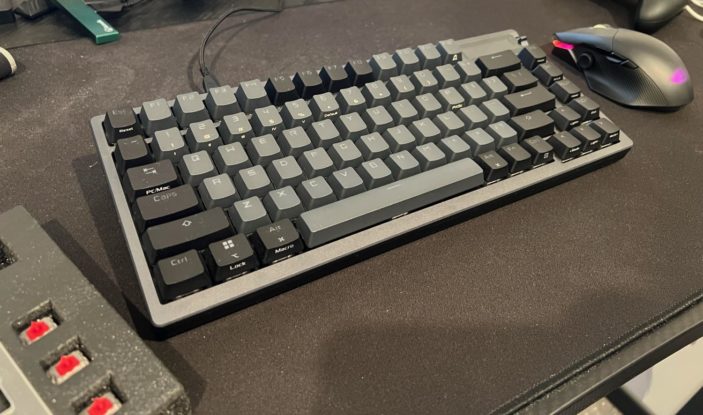
As long-winded as the name might sound, the Asus ROG Azoth 75% wireless mechanical gaming keyboard gets a lot right. For the premium A$399 price tag, it provides a sleek design, sturdy build quality, and satisfying and responsive NX switches. While it feels great to use for gaming and general typing, the featured corner OLED screen and scrolling knob leave a little more to be desired, even if they are minor hiccups to what is otherwise one of the best high-end options on the market.
Design
The ROG Azoth’s 75% design is certainly slim and stylish, along with almost no bezel or wasted surrounding areas, for maximum efficiency and space on the desk. While it’s not as snug as the Apex Pro TKL in terms of design, I do like how the directional arrow keys sit under the ‘Enter’ key, while the secondary function keys like ‘Insert’, ‘Delete’, ‘PageUp’ and ‘PageDown’ are aligned vertically along the edge.
For a mostly plastic build, the ROG Azoth is incredibly hefty. Weighing in at just under 1.18kg, it’s quite heavy for a keyboard of this size, when compared to the Apex Pro TKL, which comes in at 1.07kg. It’s worth noting here that added weight in keyboards isn’t necessarily a bad thing, as it translates here to an incredibly sturdy design and one that’s free from any creaks and general flexing under pressure. Available in both NX Red and NX Brown switches, it’s no surprise that they feel fantastic; although we’ll touch on this a little later.

The amount of premium keyboards on the market that are opting in for an OLED screen is certainly increasing, as the ROG Azoth has decided to join the conversation. The 2-inch OLED screen located in the top right-hand corner allows for a number of uses. It can act as the battery gauge when used wirelessly, along with a bunch of Armoury Crate options including lighting setups and assigned shortcuts.
It’s certainly nice to have those options there, but I also feel like these screens generally contribute to the higher price point without providing any real value. Yes, it’s nice to know how much charge there is left on the keyboard, but I’m willing to bet people won’t be relying on this screen for long.
The keyboard also features a toggle/scroll wheel next to that OLED screen, but it left me with more than a few questions. Right off the bat, the wheel itself looks like it can be pushed both upwards and towards, almost like a lever of sorts. But as it only clicks slightly in each direction. it feels a little deceiving in terms of looks and general functionality.

Sure, you can customise it to perform multiple functions like device volume and track control, but it simply feels a little underwhelming, to the point where I rarely relied on it for anything important.
Functionality
Our version of the ROG Azoth featured the NX Red switches, which are smooth and more linear. While I personally prefer the clicky bumps in the NX Brown switches, these still feel fantastic. Their linear feel makes them perfect for multitasking, particularly for someone like me, who generally uses their keyboards for gaming and extensive typing regularly.
The ROG NX Red switches provide 40 grams of actuation force, with a 1.8mm point of actuation. This makes the PBT doubleshot keycaps themselves a little lighter and as a result, easier to press when compared to something like Logitech’s Blue switches, or even those NX Brown switches, which is something to consider when determining daily use.

But it’s also worth noting here that these are not analogue switches in any way, unlike SteelSeries’s Omnipoint switches, meaning they’ll have to be pushed in to activate. But as they are, there’s never a time when you’ll feel like you’ve missed a key press. If you’re a messy typer like I am, you’re even less likely to land on neighbouring keys by accident.
While the keys themselves are fantastic, the ROG Azoth comes included with its own DIY modding kit, for those interested in taking their customisable options to the next level. While the pre-lubricated switches are fine to use out of the box for those not interested, it’s a nice touch to be able to give the keyboard itself some extra life down the track.
Customisation & Software
If you don’t already own an Asus desktop or laptop, there’s no way around it; Asus’ Armoury Crate can be a pain at times. Firstly, it’s a hefty 3GB install, so be ready to make way for it. Secondly, it doubles as a general computing assistant, giving you updates on your GPU and CPU temps. If you’re interested in simply customising the keyboard, it’s definitely a little bloated.

When it comes to customising the keyboard itself, the ROG Azoth gives you the ability to customize anything you can imagine, from key commands and macros to per-key RGB lighting setups, along with images that can even be displayed on the OLED screen. While this feels like standard practice, this portion of the software is easy enough to use and changes are updated on the fly.
The real star of the show, however, is the aforementioned DIY modding kit that comes included. Here you’ll find three spare NX Red switches, a switch-pulling tool and even extra lubrication along with a lubrication board to place switches in, should you want to add some extra glide.

Like the OLED keyboard, it’s admittedly not essential for a keyboard’s success. But here, it feels like a nice inclusion to encourage using the ROG Azoth in the long run, adding value and justification to its high-end price tag. Given that all these parts come included, there’s really no reason not to mess around and try new configurations.

Verdict & Value
The Asus ROG Azoth 75% wireless mechanical gaming keyboard may be flawed at times, thanks to its deceiving control wheel and underwhelming OLED screen, but I can’t overstate the premium nature of its build quality and satisfying switches.
Those NX Red switches are simply a joy to use on multiple fronts, from gaming to typing, while the included DIY modding kit feels like a great inclusion that justifies that premium price and general longevity. On top of that, it’s also encouraging newcomers to jump on board to cater for an experience they would prefer and to find new configurations that they may not have otherwise considered. Even at A$399, the Asus ROG Azoth competes strongly with similarly priced alternatives, making this a premium mechanical keyboard you shouldn’t skip on.
![]()
![]()
![]()
![]()
![]()
FOUR STARS (OUT OF FIVE)
Highlights: Incredibly satisfying NX Red switches; Premium build quality
Lowlights: Toggle wheel feels unsatisfying to use; OLED screen adds more to the price than it does to functionality
Manufacturer: Asus
Price: A$399
Available: Now
Review based on unit supplied by Asus.
